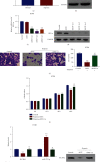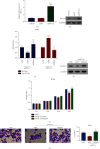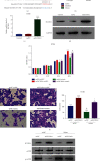miR-373-3p Regulates the Proliferative and Migratory Properties of Human HTR8 Cells via SLC38A1 Modulation
- PMID: 35837487
- PMCID: PMC9274228
- DOI: 10.1155/2022/6582357
miR-373-3p Regulates the Proliferative and Migratory Properties of Human HTR8 Cells via SLC38A1 Modulation
Abstract
The genetic pathogenesis of selective intrauterine growth restriction (sIUGR) remains elusive, with evidence suggesting an important role of epigenetic factors such as microRNAs. In this study, we explored the relevance of miR-373-3p to the occurrence of sIUGR. Hypoxia enhanced the levels of miR-373-3p and hypoxia-inducible factor (HIF)-1α, while HIF-1α knockdown not only boosted the migration and proliferation of HTR8 cells but also suppressed the hypoxia-induced upregulation of miR-373-3p and SLC38A1. By contrast, HIF-1α overexpression induced miR-373-3p downregulation and SLC38A1 upregulation, reducing cell growth and migration, which could be reversed by a miR-373-3p inhibitor. Importantly, the miR-373-3p inhibitor and mimic reproduced phenomena similar to those induced by HIF-1α downregulation and overexpression, respectively (including altered SLC38A1 expression, mTOR activation, cell growth, and migration). Mechanistically, the miRNA regulated cell behaviors and related mTOR signaling by targeting SLC38A1 expression through an interaction with the 3'-untranslated region of SLC38A1. The placental tissues of smaller sIUGR fetuses exhibited miR-373-3p and HIF-1α upregulation, SLC38A1 downregulation, and activated mTOR. Overall, miR-373-3p appears to restrict the growth and migration of HTR8 trophoblast cells by targeting SLC38A1, as observed in the placental tissues associated with smaller sIUGR fetuses, and it could have utility in the diagnosis and treatment of this disorder.
Copyright © 2022 Lu Chen et al.
Conflict of interest statement
The authors declare that they have no conflicts of interest.
Figures




Similar articles
-
miRNA-210-3p regulates trophoblast proliferation and invasiveness through fibroblast growth factor 1 in selective intrauterine growth restriction.J Cell Mol Med. 2019 Jun;23(6):4422-4433. doi: 10.1111/jcmm.14335. Epub 2019 Apr 16. J Cell Mol Med. 2019. PMID: 30993882 Free PMC article.
-
MicroRNA-593-3p regulates insulin-promoted glucose consumption by targeting Slc38a1 and CLIP3.J Mol Endocrinol. 2016 Nov;57(4):211-222. doi: 10.1530/JME-16-0090. Epub 2016 Sep 9. J Mol Endocrinol. 2016. PMID: 27613819
-
MiR-203a-3p inhibits retinal angiogenesis and alleviates proliferative diabetic retinopathy in oxygen-induced retinopathy (OIR) rat model via targeting VEGFA and HIF-1α.Clin Exp Pharmacol Physiol. 2020 Jan;47(1):85-94. doi: 10.1111/1440-1681.13163. Epub 2019 Oct 7. Clin Exp Pharmacol Physiol. 2020. PMID: 31408201
-
Hypoxia-responsive miR-141-3p is involved in the progression of breast cancer via mediating the HMGB1/HIF-1α signaling pathway.J Gene Med. 2020 Oct;22(10):e3230. doi: 10.1002/jgm.3230. Epub 2020 Jun 11. J Gene Med. 2020. PMID: 32436353 Free PMC article.
-
Induction of lncRNA NORAD accounts for hypoxia-induced chemoresistance and vasculogenic mimicry in colorectal cancer by sponging the miR-495-3p/ hypoxia-inducible factor-1α (HIF-1α).Bioengineered. 2022 Jan;13(1):950-962. doi: 10.1080/21655979.2021.2015530. Bioengineered. 2022. PMID: 34969360 Free PMC article.
Cited by
-
Identification and validation of five ferroptosis-related molecular signatures in keloids based on multiple transcriptome data analysis.Front Mol Biosci. 2025 Jan 6;11:1490745. doi: 10.3389/fmolb.2024.1490745. eCollection 2024. Front Mol Biosci. 2025. PMID: 39834787 Free PMC article.
References
-
- Wen H., Hu Y., Chen L., Zhao L., Yang X. miR-338-5p targets epidermal growth factor-containing fibulin-like extracellular matrix protein 1 to inhibit the growth and invasion of trophoblast cells in selective intrauterine growth restriction. Reproductive Sciences . 2020;27(6):1357–1364. doi: 10.1007/s43032-020-00160-3. - DOI - PMC - PubMed
MeSH terms
Substances
LinkOut - more resources
Full Text Sources
Miscellaneous

